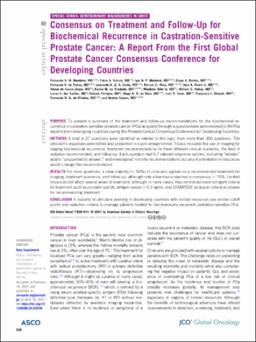| dc.contributor.author | Sade, Juan P. | |
| dc.contributor.author | Monteiro, Fernando. | |
| dc.contributor.author | Schutz, Fabio. | |
| dc.contributor.author | Et al. | |
| dc.date.accessioned | 2023-06-23T15:01:38Z | |
| dc.date.available | 2023-06-23T15:01:38Z | |
| dc.date.issued | 2021-04 | |
| dc.identifier.citation | JCO Glob Oncol . 2021 Apr;7:538-544. | es |
| dc.identifier.issn | 2687-8941 | |
| dc.identifier.uri | https://riu.austral.edu.ar/handle/123456789/2200 | |
| dc.identifier.uri | https://www.ncbi.nlm.nih.gov/pmc/articles/PMC8162965/pdf/go-7-go.20.00508.pdf | |
| dc.description | Disponible en: https://ascopubs.org/doi/10.1200/GO.20.00508?url_ver=Z39.88-2003&rfr_id=ori:rid:crossref.org&rfr_dat=cr_pub%20%200pubmed | es |
| dc.description.abstract | Abstract
Purpose: To present a summary of the treatment and follow-up recommendations for the biochemical recurrence in castration-sensitive prostate cancer (PCa) acquired through a questionnaire administered to 99 PCa experts from developing countries during the Prostate Cancer Consensus Conference for Developing Countries.
Methods: A total of 27 questions were identified as related to this topic from more than 300 questions. The clinician's responses were tallied and presented in a percentage format. Topics included the use of imaging for staging biochemical recurrence, treatment recommendations for three different clinical scenarios, the field of radiation recommended, and follow-up. Each question had 5-7 relevant response options, including "abstain" and/or "unqualified to answer," and investigated not only recommendations but also if a limitation in resources would change the recommendation.
Results: For most questions, a clear majority (> 50%) of clinicians agreed on a recommended treatment for imaging, treatment scenarios, and follow-up, although only a few topics reached a consensus > 75%. Limited resources did affect several areas of treatment, although in many cases, they reinforced more stringent criteria for treatment such as prostate-specific antigen values > 0.2 ng/mL and STAMPEDE inclusion criteria as a basis for recommending treatment.
Conclusion: A majority of clinicians working in developing countries with limited resources use similar cutoff points and selection criteria to manage patients treated for biochemically recurrent castration-sensitive PCa. | es |
| dc.language.iso | en | es |
| dc.publisher | American Society of Clinical Oncology | es |
| dc.rights | Attribution-NonCommercial-NoDerivatives 4.0 Internacional | * |
| dc.rights.uri | http://creativecommons.org/licenses/by-nc-nd/4.0/ | * |
| dc.subject | Prostate Cancer. | es |
| dc.subject | Castration prostate cancer. | es |
| dc.subject | Biochemical Recurrence. | es |
| dc.title | Consensus on Treatment and Follow-Up for Biochemical Recurrence in Castration-Sensitive Prostate Cancer: A Report From the First Global Prostate Cancer Consensus Conference for Developing Countries | es |
| dc.type | Article | es |


